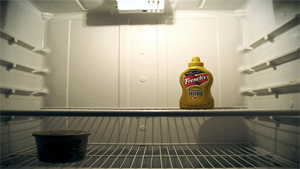Poverty Nutrition III: Empty Refrigerator Contingency Plan
by
 So the only things in the refrigerator are jelly and ketchup. Again. Despite the best intentions, sometimes eating home-cooked meals as a grad student seems even more hopeless than finding a time when all the members of your thesis committee can meet together.
So the only things in the refrigerator are jelly and ketchup. Again. Despite the best intentions, sometimes eating home-cooked meals as a grad student seems even more hopeless than finding a time when all the members of your thesis committee can meet together.
However, with a proper risk management strategy, you don’t have to starve. It’s possible to keep emergency groceries on hand to make delicious and nutritionally balanced meals even when your refrigerator and your bank account are equally bare. If you’ve ever contemplated making a K&B sandwich (that’s ketchup and bread), this post is for you.
All of the ingredients for these recipes can be stored in the pantry or freezer, and each recipe can be made in under an hour including defrosting and prep time. Stock up on ingredients when they’re on sale and you’ll always be prepared.
.
Shrimp coconut curry
Ingredients
- 2 cups rice
- 1 can chicken broth
- 2 tbsp Thai curry paste (I like Mae Ploy panang curry paste.)
- 1 bag frozen stir-fry vegetable blend
- 1 lb frozen small peeled shrimp, thawed under cool running water
- 1 can coconut milk
Cook rice according to the package directions. While the rice is cooking, heat the chicken broth to a simmer in a large pot. Stir in the curry paste. Add the vegetables and cook for about 10 minutes, until the vegetables are thawed and the liquid returns to a simmer. Add the shrimp and cook just until they turn pink, about 5 minutes. Remove from heat and stir in the can of coconut milk. Serve over rice.
This recipe reheats well, so I generally divide the leftovers into individual containers and eat them for lunch. Don’t microwave the curry too long during reheating, because the coconut milk is delicate.
.
.
Mediterranean microwave-steamed tilapia
Ingredients (single serving)
- 1/2 cup cooked rice (crusty dried out leftover rice is fine)
- 1 frozen tilapia filet
- 1/8 tsp salt
- 6 canned artichoke heart quarters (1 1/2 hearts), plus 2 tbsp juice from the can
- 2 tbsp balsamic vinegar
- 1 tbsp olive oil
- 1/4 cup crumbled feta cheese (Pre-crumbled feta has a relatively long refrigerated lifespan. For even longer storage, shake the container to loosen the crumbles, then freeze it.)
Sprinkle salt over the rice and fish. On a large sheet of parchment paper or waxed paper, stack the rice, fish, and artichoke hearts. Drizzle artichoke juice, balsamic vinegar, and olive oil on top. Fold the paper into a pouch around the food and staple it shut or tuck the ends underneath to trap the steam during cooking. Place the pouch in a large bowl or container to catch any spills.
Microwave until the fish is cooked, turning halfway through cooking. In my 1100 watt microwave, this takes about five minutes. Let the pouch rest for two minutes before opening it.
.
.
Peanut sauce noodles with tofu and snap peas
Ingredients
- 1/2 cup peanut butter
- 2 tbsp warm water
- 2 tbsp rice vinegar
- 2 tbsp soy sauce
- 1 tbsp grated ginger
- (Store ginger root whole in the freezer, wrapped in plastic wrap. Grate it as needed, without defrosting it.)
- 1 block firm tofu, cut into 1/2 inch cubes
- 1 bag frozen snap peas
- 12 oz rice noodles or angel hair pasta
Cook the pasta according to the package directions, adding the peas to the cooking water in the last few minutes of cooking to thaw them. Drain the noodles and peas in a strainer.
Stir together the peanut butter, water, vinegar, soy sauce and ginger in a small bowl, warming it for a few seconds in the microwave if needed to help it blend. Add more water if necessary to form a sauce-like consistency. Toss the sauce and tofu with the noodles and peas.
Note: Consider making peanut sauce in large batches and freezing down aliquots in an ice cube tray for future use. Foods that are improved by coating with peanut sauce include rotisserie chicken, broccoli, scrambled eggs, baby carrots, and yes, even ramen noodles.
.
Dr. Barrilleaux is a postdoctoral scholar at the University of California, Davis, in the laboratory of Dr. Paul Knoepfler. She received a Ph.D. in Chemical and Biomolecular Engineering from Tulane University. She has eaten nearly 2000 breakfasts as a graduate student, many of which involved sniffing a gallon of milk to decide if the expiration date was serious or just a suggestion. She is also an occasional contributor to the Knoepfler Lab Stem Cell Blog.
.
Still hungry (and poor)? Check out other recipes in this series:
Poverty Nutrition I: A Fugue in Egg Minor
Poverty Nutrition II: Beans & Rice (And Their Infinite Variety)
.
.

